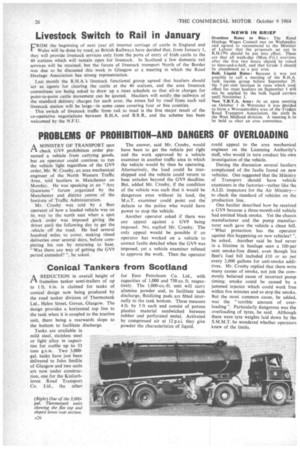PROBLEMS OF PROHIBITION AND DANGERS OF OVERLOADING
Page 28

If you've noticed an error in this article please click here to report it so we can fix it.
A MINISTRY OF TRANSPORT spot 1—k check GV9 prohibition order prevented a vehicle from carrying goods, but an operator could continue to run the vehicle light regardless of the GV9 order, Mr. W. Crosby, an area mechanical engineer of the North Western Traffic Area, told hauliers in Manchester on Monday. He was speaking at an "Any Questions" forum organized by the Manchester and district centre of the Institute of Traffic Administration.
Mr. Crosby was told by a fleet operator of how a loaded vehicle was on its way to the north east when a spot check order was imposed giving the driver until the following day to get the :ehicle off the road. He had several hundred miles to cover, making timed deliveries over several days, before completing his run by returning to base. "Was there any way of getting the GV9 period,extended? ", he asked. The answer, said Mr. Crosby, would have been to get the vehicle put right and the work approved by a vehicle examiner in another traffic area in which the vehicle would by then be operating. Alternatively, the load could be transhipped and the vehicle could return to base unladen beyond the GV9 deadline. But, added Mr. Crosby, if the condition of the vehicle was such that it would be dangerous even without its load, the M.o.T. examiner could point out the defects to the police who would have power to stop the vehicle.
Another operator asked if there was any appeal against a GV9 being imposed. No, replied Mr. Crosby. The only appeal would be possible if an operator has worked on a vehicle to correct faults detailed when the GV9 was imposed, yet a vehicle examiner refused to approve the work. Then the operator could appeal to the area mechanical engineer on the Licensing Authority's staff, who would in turn conduct his own investigation of the vehicle.
During the discussion several hauliers complained of the faults found on new vehicles. One suggested that the Ministry of Transport should have vehicle examiners in the factories—rather like the AID. inspectors for the Air Ministry— to check the standard of vehicles on the production line.
One haulier described how he received a GV9 because a three-month-old vehicle had emitted black smoke. Yet the chassis manufacturer and the pump manufacturer each gave the vehicle a clean bill. "What protection has the operator against this happening on new vehicles? ", he asked. Another said he had never in a lifetime in haulage seen a 100 per cent smoke-free diesel, even though his fleet's fuel bill included £10 or so per every 2,000 gallons for anti-smoke additives. Mr. Crosby replied that there were many causes of smoke, not just the commonly. believed cause of incorrect pump timing; smoke could be caused by a jammed injector which could work free within five minutes and so stop the smoke. But the most common cause, he added, was the 'terrible amount of overloading ". Particularly dangerous was the overloading of tyres, he said. Although there were tyre weights laid down by the S.M.M.T. he wondered whether operators knew of the limits.












































































































